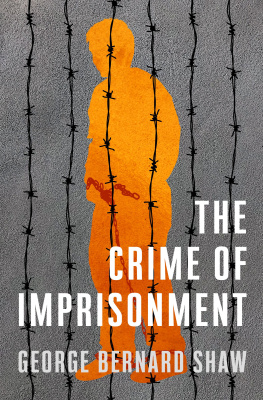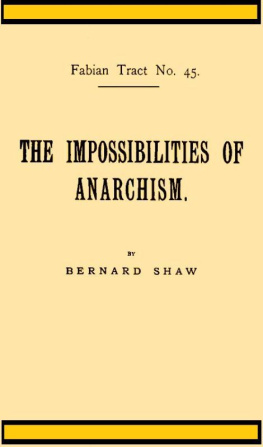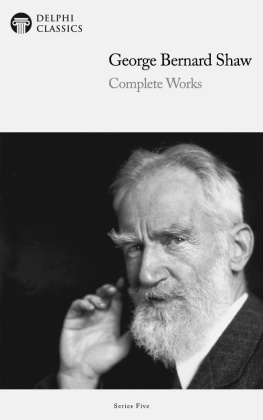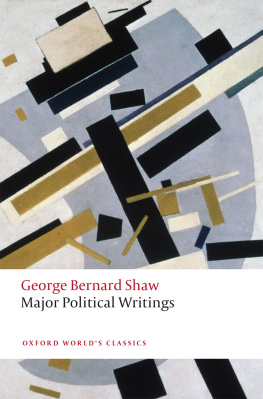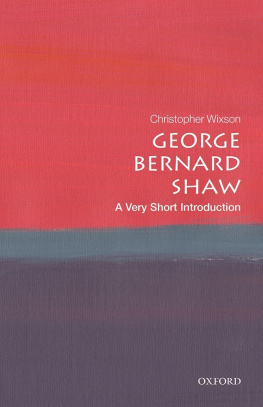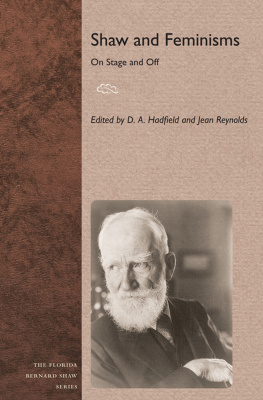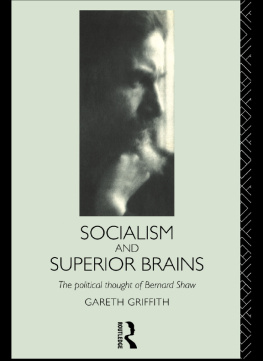Bernard Shaw

Florida A&M University, Tallahassee
Florida Atlantic University, Boca Raton
Florida Gulf Coast University, Ft. Myers
Florida International University, Miami
Florida State University, Tallahassee
University of Central Florida, Orlando
University of Florida, Gainesville
University of North Florida, Jacksonville
University of South Florida, Tampa
University of West Florida, Pensacola

University Press of Florida
Gainesville
Tallahassee
Tampa
Boca Raton
Pensacola
Orlando
Miami
Jacksonville
Ft. Myers
| Bernard Shaw | A Life |
| A. M. Gibbs |
Copyright 2005 by A. M. Gibbs
Printed in the United States of America on acid-free paper
All rights reserved
10 09 08 07 06 05 6 5 4 3 2 1
A record of cataloging-in-publication data is available from
the Library of Congress.
ISBN 0-8130-2859-0
The University Press of Florida is the scholarly publishing agency for the State University System of Florida, comprising Florida A&M University, Florida Atlantic University, Florida Gulf Coast University, Florida International University, Florida State University, University of Central Florida, University of Florida, University of North Florida, University of South Florida, and University of West Florida.
University Press of Florida
15 Northwest 15th Street
Gainesville, Fl 32611-2079
http://www.upf.com
To Donna
I rejoice in life for its own sake. Life is no brief candle to me. It is a sort of splendid torch which I have got hold of for the moment; and I want to make it burn as brightly as possible before handing it on to future generations.
Shaw, in a speech delivered at Brighton, Eng., 1907
As institution, the author is dead: his civil status, his biographical person have disappeared; dispossessed, they no longer exercise over his work the formidable paternity whose account literary history, teaching, and public opinion had the responsibility of establishing and renewing; but in the text, in a way, I desire the author: I need his figure (which is neither his representation nor his projection), as he needs mine.
Roland Barthes, Mythologies
If a man is a deep writer all his works are confessions.
Shaw, Sixteen Self Sketches
Funding to assist in publication of this book was generously provided by the David and Rachel Howie Foundation
Contents
Illustrations
| BL | British Library |
| BLPES | British Library of Political and Economic Science |
| BSTC | F. E. Loewenstein, Bernard Shaw Through the Camera, 1948 |
| Guelph | Dan H. Laurence Collection, University of Guelph Library |
| Getty | Getty Images |
| PTBA | Photo Taken by Author |
| Tas | Private Collection, Tasmania |
Illustration Location
Between
Between
Annie BesantGetty
Between
Between
Shaw in the Strand, London, May 1927Getty
Sir Edward Elgar conductingGetty
Shaw, aged eighty-nine, in garden at AyotGetty
A Note on Quotations from Shaws Writings
In quotations from Shaws writings in the present work, his preferences regarding spelling and punctuation have been preserved. These include the omission of apostrophes in words such as dont, youve, and didnt, where no ambiguity results. Quotations from Shaws novels are from the Constable standard editions. Quotations from the plays are from the Penguin Classics editions, except as indicated in the discussion of Pygmalion.
Introduction
The writing of this new life of Shaw was largely inspired by a compulsive curiosity and fascination similar to that which drives the central characters in A. S. Byatts novel Possession: A Romance, which deals with a biographical quest. Having been familiar with Shaws work since schooldays, and having written about various aspects of his life and career in other books and essays, I became obsessed with the idea of trying to come to grips with the man and his inner life and personality in a biographical study. The materials for such a study are dauntingly numerous and very widely scattered. During the course of his long life, Shaw wrote over fifty plays and playlets, five novels, and several short stories. He is estimated to have written more than a quarter of a million letters, many of which are still being published in special editions that supplement the four-volume collection edited by Dan H. Laurence. The prefaces he wrote to his own works and those of others, his music and theater criticism, book reviews, and his autobiographical writings are published in multiple volumes. His other nondramatic writingssuch as political tracts and polemical works like Common Sense About the War (1914)also fill many volumes. His contributions to periodical literature number in the thousandsenough to fill the CVs of dozens of academics. Apart from Shaws published writings, there are large collections of unpublished materials relevant to biographical study in various institutions in the United Kingdom, North America, and Canada. Small caches of Shaviana have a way of turning up in almost every corner of the world. Some of the material used in the present work was found in a private house belonging to descendants of one of Shaws uncles in Tasmania, an island state of Australia lying off the southern coast of the mainlandthe next stop being the South Pole.
The vast size of the subject is not the only problem in the field of Shaw biography. In William Goldings classic tale The Lord of the Fliesto invoke another novelistthe group of schoolboys who are cast up on a desert island without any adults work out a way of controlling their early discussions about their situation and plans by passing round a large seashell, which they call the conch. The person who holds the conch has a right to speak without interruption. As far as the story of his own life was concerned, Shaw went to great lengths during his lifetime to ensure that the biographical conch remained firmly in his own hands. Even in his collection of autobiographical essays called Sixteen Self Sketches (1949), published in his ninety-third year, he was still tenaciously in control of his story. One of the last chapters in the book is called Biographers Blunders Corrected. The Shavian stamp on his life story began to be asserted in the 1890s and early twentieth century, when he was gradually becoming a well-known figure in literary and intellectual circles, with the writing of autobiographical articles about himself with catchy titles such as Who I Am, and What I Think. The early biographies of Shaw by Archibald Henderson and Hesketh Pearson were in many ways forms of surrogate autobiography in that Shaw fed both writers with large quantities of material that became the staple of their works. The best authority on Shaw is Shaw, the playwright told Archibald Henderson; but even Henderson, influenced as he was by Shaw, came to realize that his heros word was not always to be trusted. The Shavian account of his life, particularly of its early years, has been uncritically adopted and lavishly embroidered by all of his major biographers. One of the aims of this book has been to pass the conch around and let other voices from the past relate the story of Shaws life and associations.




